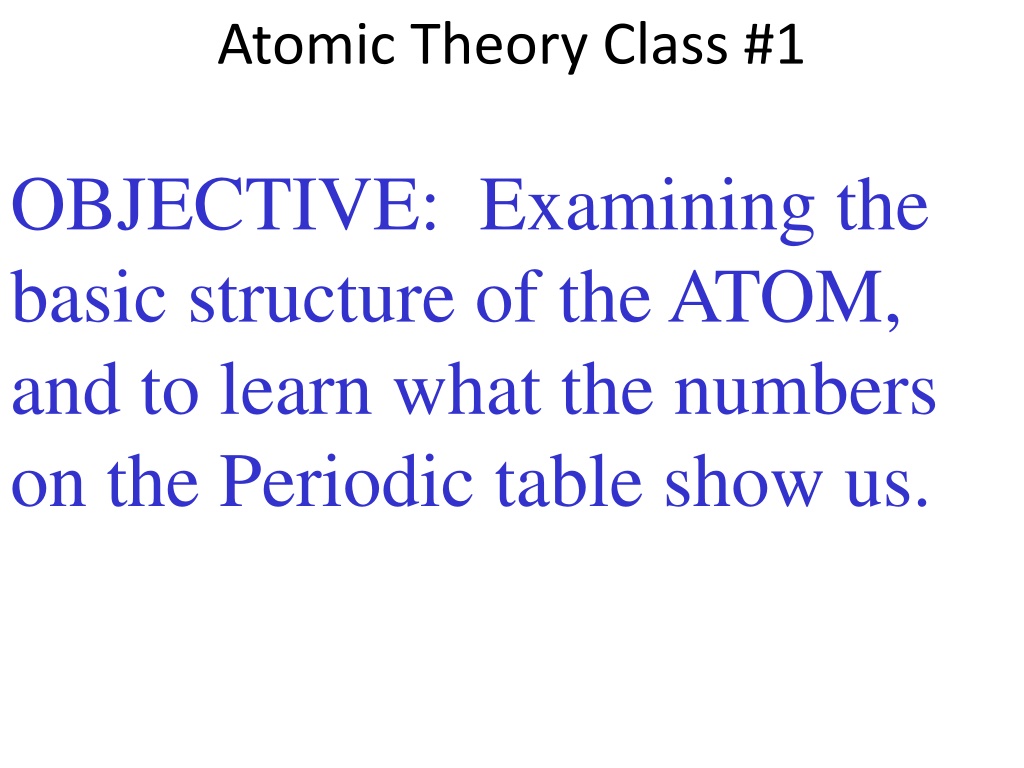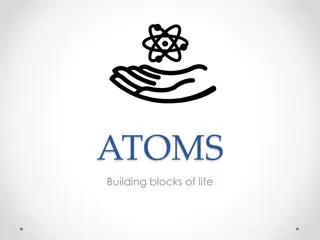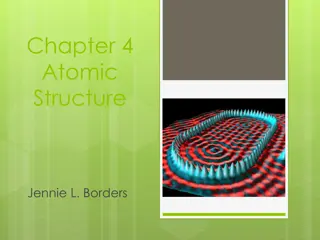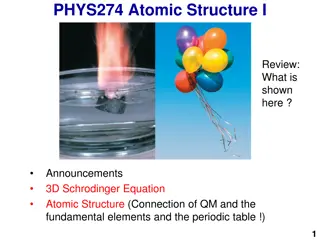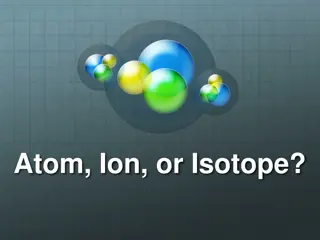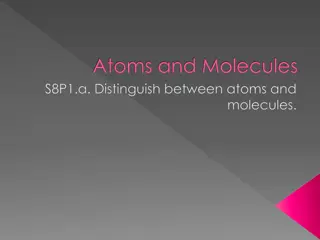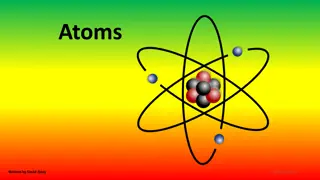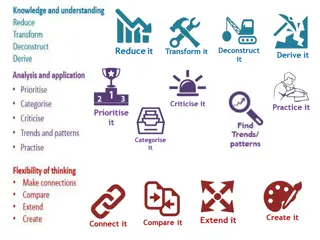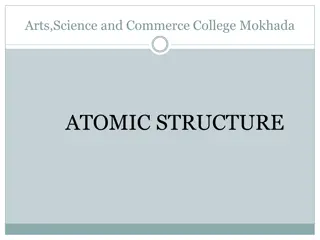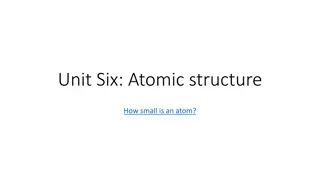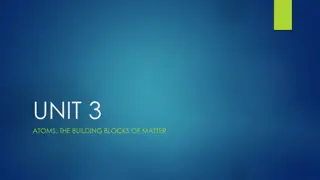Understanding the Basic Structure of Atoms: Atomic Theory Class #1
Exploring the fundamental components of atoms, including protons, neutrons, and electrons, their charges, symbols, masses, and locations within the atom. We delve into the concept of atomic mass units (AMU) and the structure of the nucleus, as well as the behavior of electrons in relation to the nucleus. This introductory class provides a clear overview of atomic structure and its key components.
Uploaded on Sep 07, 2024 | 0 Views
Download Presentation

Please find below an Image/Link to download the presentation.
The content on the website is provided AS IS for your information and personal use only. It may not be sold, licensed, or shared on other websites without obtaining consent from the author. Download presentation by click this link. If you encounter any issues during the download, it is possible that the publisher has removed the file from their server.
E N D
Presentation Transcript
Atomic Theory Class #1 OBJECTIVE: Examining the basic structure of the ATOM, and to learn what the numbers on the Periodic table show us.
1. All atoms are made up of three sub-atomic (smaller than atoms) parts. They are the Parts of the atom Particle Charge Symbol Mass Location proton neutron electron
1. All atoms are made up of three sub-atomic (smaller than atoms) parts. They are the Parts of the atom Particle Charge Symbol Mass Location Positive + p+ proton 1 amu nucleus neutron electron
1. All atoms are made up of three sub-atomic (smaller than atoms) parts. They are the Parts of the atom Particle Charge Symbol Mass Location Positive + p+ proton 1 amu nucleus Neutral n neutron 1 amu nucleus electron
1. All atoms are made up of three sub-atomic (smaller than atoms) parts. They are the Parts of the atom Particle Charge Symbol Mass Location Positive + p+ proton 1 amu nucleus Neutral n neutron 1 amu nucleus flying around the nucleus Negative zero in high school e- electron
2. The mass of an electron is NOT ZERO, but its so small, only 1 1750of a proton or neutron, that we will disregard its mass. This is an intro class; the mass is not zero, but it is so small that we don t count it. The nucleus is the small, dense center of an atom where the protons and neutrons live. Electrons fly around outside, relatively far away.
3. The nucleus is the small, dense, positive center of an atom where the protons live (and so do the neutrons). 4. Electrons fly around outside, relatively far away. In this model, the nucleus is the yellow ball in the middle. It does not show it, but inside must be three protons and probably 4 neutrons. This is a model of atom #3, which is LITHIUM. It s a cartoon, it s not even what we think atoms look like, but it s cute.
5. AMU is atomic mass unit. It s a super small mass, and there is a lot of math to make it equivalent to 1.67 x 10-24 gram, but we WILL NEVER DO THIS MATH, okay? Never ever. 6. In high school a proton is = 1 amu. A neutron is = 1 amu too. 7. In high school, because the mass of the electron is so much smaller, we discount it in our calculations, but it is NOT REALLY ZERO.
8. Missing numbers, we will discuss them soon, not today. Atomic Mass 12.011 Atomic Number 6 2-4 Electron Configuration
9. Atomic Mass Numbers will be rounded to the nearest whole number (they re not whole numbers, patience) 10. Mass Number = mass of protons + neutrons Atomic Mass = p+ plus n
11. The mass of sodium is 23 AMU. It has a total of 11 protons + ___ neutrons. = 23 AMU
11. copy 23 AMU Sodium mass protons + neutrons Minus atomic number -11 - protons 12 Equal neutrons
12. How many protons, neutrons and electrons are in TIN (element number 50)? Mass of Sn = 119 = p+ + n atomic # # p+
12. How many protons, neutrons and electrons are in TIN (element number 50)? Mass of Sn = 119 = p+ + n atomic # 50 # p+ 69 = # n Tin has 50 protons, 50 electrons, and 69 neutrons.
13 This slide left intentionally blank; you know why.
14. All atoms are electrically neutral, the number of p+ = e- The positives = the negatives. # p+ # e-
15. How many p+, n and e- are in INDIUM? minus protons Indium mass # protons PLUS # neutrons = = neutrons
15. How many p+, n and e- are in INDIUM? minus protons Indium mass # protons PLUS # neutrons = 115 49 equals neutrons 66 The protons = electrons, so indium has 49 electrons also.
16. How many p+, n and e- are in NIOBIUM (#41)? minus protons Niobium mass # protons PLUS # neutrons = equals neutrons The protons = electrons, so niobium has electrons also.
16. How many p+, n and e- are in NIOBIUM (#41)? minus protons 93 Niobium mass # protons PLUS # neutrons = 41 52 equals neutrons The protons = electrons, so niobium has 41electrons also.
17. How many p+, n and e- are in IRON (#26)? Iron mass minus protons # protons PLUS # neutrons = equals neutrons The protons = electrons, so iron has electrons also.
17. How many p+, n and e- are in IRON (#26)? Iron mass minus protons 56 # protons PLUS # neutrons = 26 30 equals neutrons The protons = electrons, so iron has 26 electrons also.
A more formal symbol for Calcium can also be written as: 40 20Ca Atomic mass Atomic number 18. Write the Formal Symbols for: Mercury Chlorine Copper
A more formal symbol for Calcium can also be written as: 40 20Ca Atomic mass Atomic number 18. Write the Formal Symbols for: Mercury Chlorine Copper 64 29Cu 35 17Cl 201 80Hg
Electrons dont just fly around randomly 19. Electrons stay in SHELLS or ORBITALS, which are also energy levels. 20. The closer to the nucleus, the LOWER the energy level. Electrons in shells further away from the nucleus, are in higher energy orbitals - or higher energy shells.
21. The orbitals are sized to hold a maximum number of electrons. You don t memorize how many can fit into each orbital, you just look at group 18 on the Periodic Table. These are the NOBLE GASES. They have only full orbitals.
Noble gases Electron Configuration Helium He 22 Neon Ne 23 Argon Ar 24 Krypton Kr 25 Xenon Xe 26 Radon Rn 27
Noble gases Electron Configuration Helium He 2 22 Neon Ne 23 Argon Ar 24 Krypton Kr 25 Xenon Xe 26 Radon Rn 27
Noble gases Electron Configuration Helium He 2 22 Neon Ne 2 - 8 23 Argon Ar 24 Krypton Kr 25 Xenon Xe 26 Radon Rn 27
Noble gases Electron Configuration Helium He 2 22 Neon Ne 2 8 23 Argon Ar 2 8 8 24 Krypton Kr 25 Xenon Xe 26 Radon Rn 27
Noble gases Electron Configuration Helium He 2 22 Neon Ne 2 8 23 Argon Ar 2 8 8 24 Krypton Kr 2 8 18 8 25 Xenon Xe 26 Radon Rn 27
Noble gases Electron Configuration Helium He 2 22 Neon Ne 2 8 23 Argon Ar 2 8 8 24 Krypton Kr 2 8 18 8 25 Xenon Xe 2 8 18 18 8 26 Radon Rn 27
Noble gases Electron Configuration Helium He 2 22 Neon Ne 2 8 23 Argon Ar 2 8 8 24 Krypton Kr 2 8 18 8 25 Xenon Xe 2 8 18 18 8 26 Radon Rn 2 8 18 32 18 8 27
28. Orbital Maximum electrons that fit in this orbital First 2 Second 8 Third 8, or 18 (it can stretch) Fourth 8, or 18, or 32 (wow) Fifth 8 or 18 Sixth 8 Full is relative. It is better understood as perfectly stable arrangement. These electron shells, or orbitals, can be stable in different ways. The first two never adjust. The bigger orbitals are fancy, and Group 18 tells us this, just put your finger in the right box and think.
Lets practice a little bit. 29. Find silver, how many electrons does it have?
Lets practice a little bit. 29. Find silver, how many electrons does it have? 47e- 30. Find hafnium, how many protons, electrons and how many neutrons in this element?
Lets practice a little bit. 29. Find silver, how many electrons does it have? 47e- 30. Find hafnium, how many protons, electrons and how many neutrons in this element? 72p+, 72e-, 106n 31. What element has 16 protons and 16 electrons?
Lets practice a little bit. 29. Find silver, how many electrons does it have? 47e- 30. Find hafnium, how many protons electrons and how many neutrons in this element? 72p+, 72e-, 106n 31. What element has 16 protons and 16 electrons? SULFUR 32. What is the chemical symbol for tungsten? How many electrons are in this element?
Lets practice a little bit. 29. Find silver, how many electrons does it have? 47e- 30. Find hafnium, how many protons electrons and how many neutrons in this element? 72p+, 72e-, 106n 31. What element has 16 protons and 16 electrons? SULFUR 32. What is the chemical symbol for tungsten? W How many electrons are in this element? 74e-
Atomic Theory Class #2 Objective: students will review the models of the atom through scientific history, learning how ideas progressed and were dismissed as new information was developed. Most famous chemists had remarkable mustaches. That s the easiest way to keep track of who s who in science!
33. 2400 years ago, the philosopher Democritus said: If you took anything and cut it in half, and in half, and in half, over and over, sooner or later, you would get to a piece so small that it could not be cut in half again. That indivisible particle he named ATOMOS (in Greek) We say it as ATOM The first of many mustaches in our course!
In the early 1800s John Dalton thought he could invent chemistry, it had to be bigger than a single word. He invented the Atomic Theory. On the next page is a 4-part theory, that you will have to recognize and understand. You do not have to memorize it.
34. Daltons Atomic Theory (This is so important) 1. All elements are composed of individual kinds of atoms. 2. Atoms of one element are identical. Atoms of different elements have different masses. 3. Atoms can chemically combine with other atoms IN SIMPLE WHOLE NUMBER RATIOS, to form new substances. 4. Chemical reactions change the arrangement of atoms, but when they are bonded they do not become different kinds of atoms.
35. Dalton imagined his atom to look sort of like a billiard ball. Billiards is a game like pool. The balls are hard spheres, and you can tell them apart by colors. His atoms had different masses. His atomic model was called the BILLIARD BALL MODEL
36. J. J. Thomson discovers the electron in 1897! (and later gets a Nobel Prize) 37.Thomson did a variety of experiments, some using what s called the cathode ray tube, to detect and measure electrons. He found the first subatomic particle, the electron, which was negatively charged.
38. He describes the atom as PLUM PUDDING, after what his wife s dessert looked like! He put his newly discovered negative electrons into the positive mush of the atom. If Mrs. Thomson made him chocolate chip cookies instead, his model would be the chocolate chip cookie model, with the cookie being positive, offset by the negative electrons or the chips! Dalton s electrons The Model that coulda and shoulda been! The Positive Mush of the atom. Plum Pudding
In 1908, my chemical hero, Ernest J. Rutherford discovers the nucleus! - and much more about the atom! Later, he wins a Nobel Prize. 39. Rutherford s Gold Foil Experiment helps him discover the nucleus, and figure out the basic structure of the atom. (it wasn t cake!)
40. Details of the GOLD FOIL experiment to memorize and share with your friends.
41. What does this gold foil experiment prove? 1. Atoms are mostly empty space Since most of the alpha particles pass though the foil like it s not really there. 2. He knew atoms are neutral, so the nucleus must be dense and positively charged Since the positively charged alpha particles never stuck to atoms, or they dinged off atoms, there must be a central atomic core that was bigger and positively charged. 3. Neutral atoms must therefore have the negatively charged electrons outside the nucleus Flying around like planets made sense.
42. The Rutherford Model is named the planetary model. He perceives the electrons to be flying around the atom s nucleus like the planets orbiting the Sun.
